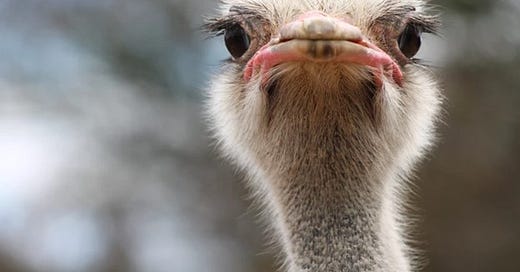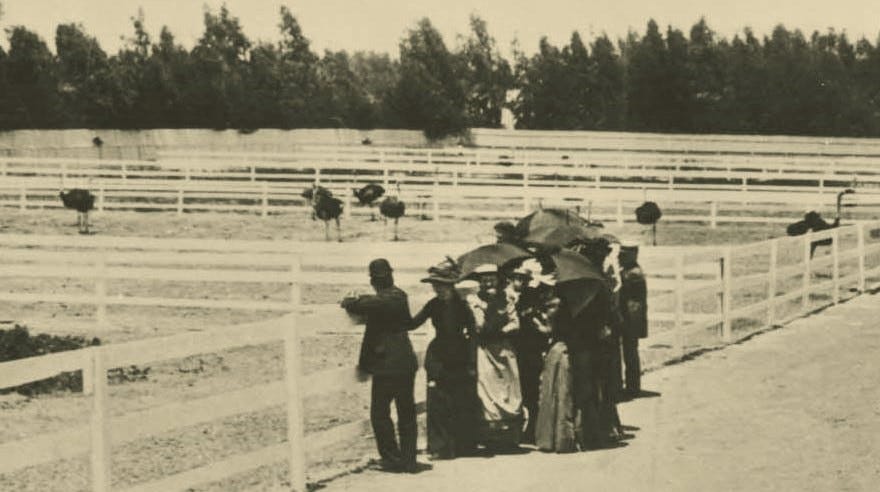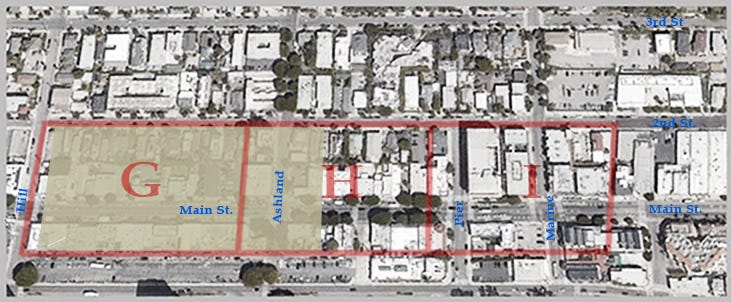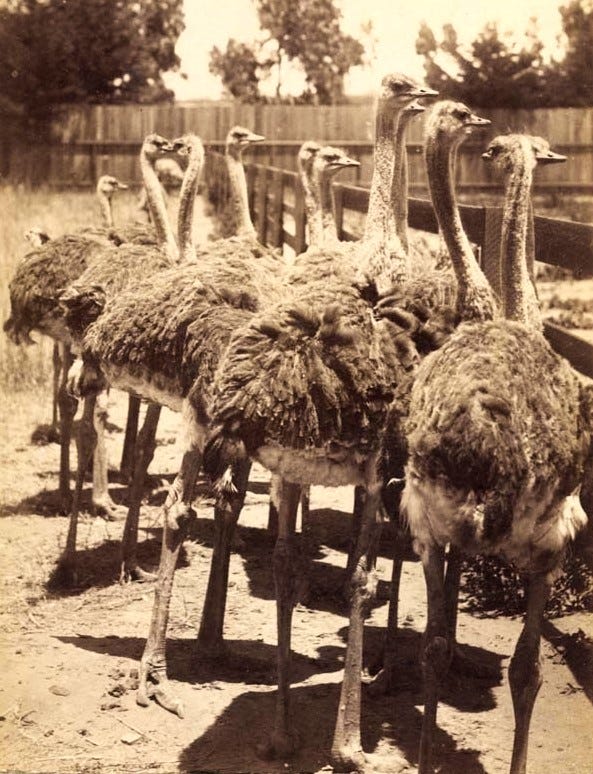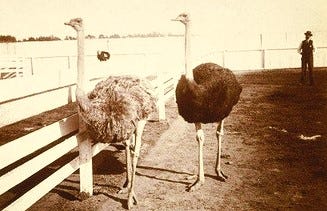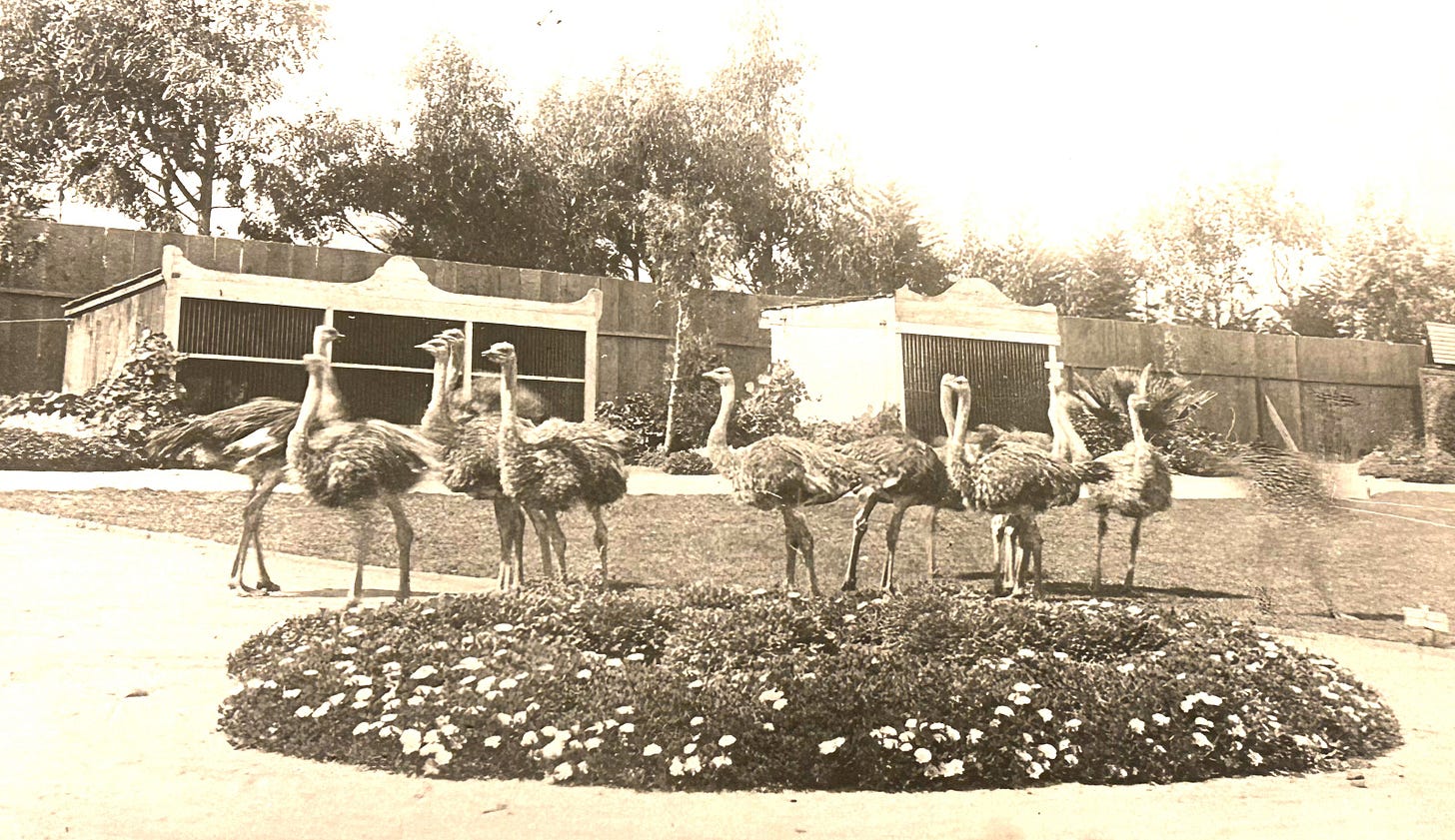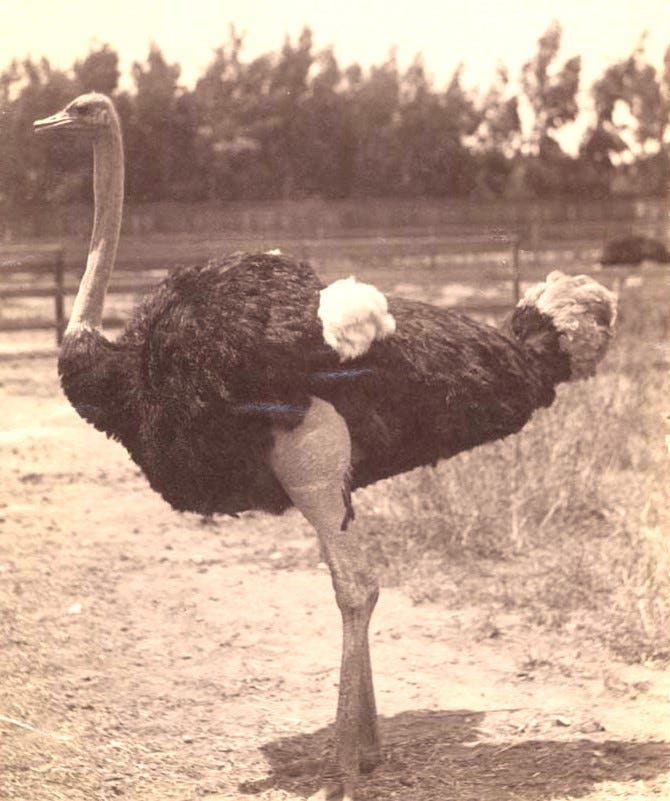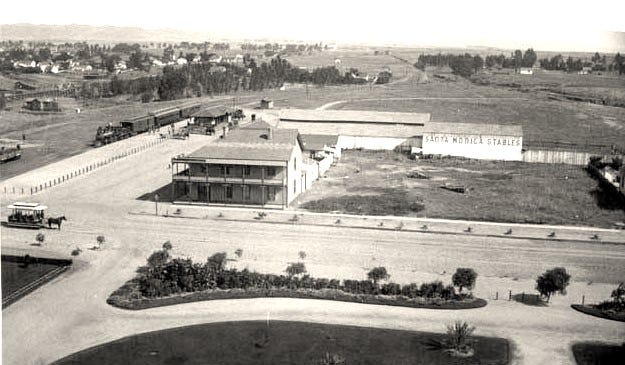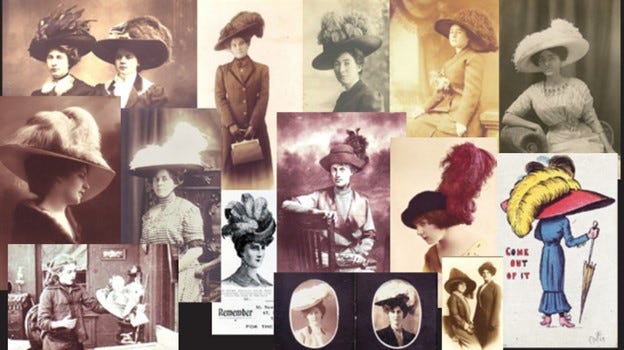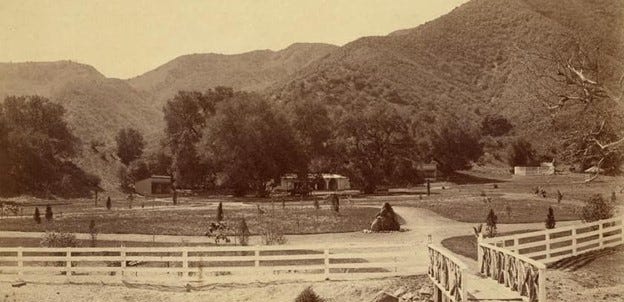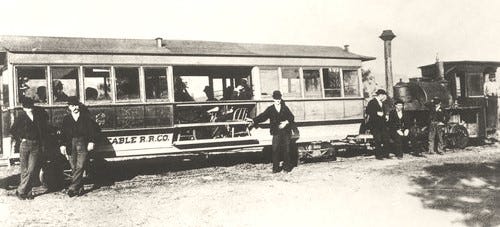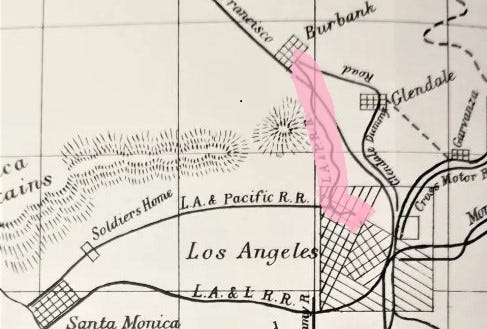In 1891, the Ocean Park Ostrich Farm, with 34 fenced-in birds, is established on 7 acres south from Hill St between 2nd St and Main St.1
The Ocean Park ostrich farm is but a short-lived (1891 - 1892) rally of the remnants of an earlier ostrich farm in Griffith Park.2
The first ostrich farm in the US is founded 7 miles northwest of Anaheim in 1882,3 and is managed by Charles J. Sketchley.4 In 1885, in a dispute with the owners, Sketchley quits and plans a new ostrich farm 6 miles northwest of downtown Los Angeles (Kenilworth) on Griffith J. Griffith’s Rancho Los Feliz.5
In 1885, a syndicate of transplanted Englishmen (Sketchley, G.P. Beauchamp,6 Frank Burkett,7 Elizabeth Laver,8 and Randolph H. Stracey9) sends Sketchley to South Africa to secure new ostriches for the Los Angeles (Kenilworth) farm.10 A railway is built in 1887 to transport curious sightseers from downtown Los Angeles to the Kenilworth ostrich farm.11 The Los Angeles (Kenilworth) ostrich farm is not a financial success.12 Sketchley sells his interest to Beauchamp for $3,500 in 1887, and Beauchamp now owns all of the ostrich farm assets.
In March 1889, after lobbying by Santa Monica interests (the Vawters)13 who are hoping to attract tourists, Beauchamp abandons Kenilworth and transfers the animals to a new Ostrich Farm at Hill and Main St in Ocean Park. Ocean Park has greater accessibility than Kenilworth, and the area also offers other attractions for tourists.14 Beauchamp dies unexpectedly in Santa Monica in December 1889.
In 1891, W.D. Vawter sells 13 acres in Ocean Park15 to Englishman H.B. Perry,16 who now owns the ostrich farm assets.17 However, by 1892, the Ocean Park Ostrich Farm is struggling. H.B. Perry sells the animals and facilities, sells the Ocean Park property,18 and returns home to England.
In 1892, the ostrich farm animals19 are moved from Ocean Park to a leased vacant lot opposite the Santa Monica Southern Pacific train depot (behind the Arcadia Hotel and near present-day Tongva Park).
Frank R. Ellis20 is the manager of the new ostrich farm. In 1895, the 3-year ground lease on the new site is up for renewal; the Santa Monica park has lost its appeal as a tourist attraction; and Ellis permanently closes the Santa Monica ostrich farm.
In 1891, Main St ends at Hill St. Main St is only extended to the City’s south border in 1893 after the ostrich farm is gone.
The Ocean Park farm is not unique. By the late 1890s, there are at least 8 ostrich farms in Southern California. The most popular is Edwin Cawston's in South Pasadena. The initial impetus for ostrich farms is the money to be made selling feathers - ostrich feathers are a big fashion item at the end of the 19th century.
The farming of ostriches for their feathers starts in South Africa around 1865. The ostrich feather trade is extremely profitable, and South Africa is the ostrich farming capital of the world. By 1880, feathers are its 4th most valuable export, after gold, diamonds, and wool. The desert town of Oudtshoorn is full of feather mansions built with ostrich profits.
In 1883, Moses Hopkins, Gaylord Wilshire, Robert L. Northam, Charles B. Polhemus, and Dwight Whiting form the California Ostrich Farming Company and purchase 22 birds from John Protheroe. Sketchley accompanies the ostriches on their trip from South Africa, and is appointed superintendent of the Anaheim farm.
Charles Jarram Sketchley (1852 - 1916). Born in England, and is a draper’s assistant near Birmingham in 1871. In Bulgaria, he serves as a British army surgeon during the Russo-Turkish War (1877-1878). He goes to South Africa and, in 1880, marries Emily Forssman (1859 – 1881) in Potchefstroom. Sketchley is the district surgeon and an ostrich farmer. During the First Boer War, he and his family are besieged in the Fort of Potchefstroom from December 1880 to March 1881 and Sketchley’s wife Emily dies. He moves to California, where in 1882, he is the first ostrich farmer in the US. In 1885, Sketchley quits the Anaheim farm and gets involved with a second farm (Kenilworth) near Los Angeles - but sells his interest in that farm in 1887. Sketchley marries Manuela “Nellie” Packard (1862–1933), and in 1888, buys 250 acres for an ostrich farm on the Sacramento River, 5 miles north of Red Bluff. This ostrich farm fails, and Sketchley, leaving his family in CA, becomes a tobacco farmer in Australia, then in Fiji, and then in Zimbabwe, where he dies.
The Los Angeles (or Kenilworth) Ostrich Farm is situated on land leased from Griffith J. Griffith in the northern part of Rancho Los Feliz on the western bank of the Los Angeles River. Griffith, who owns part (4,100 acres) of Rancho Los Feliz, leases the property for 5 years (with an option to buy) on the condition that it be maintained as an ostrich farm. He only leases the property for the ostrich farm and has no involvement with its operation. He considers the ostrich farm to be an opportunity to promote his Kenilworth and Ivanhoe subdivisions.
Granville Pelham Beauchamp (1855 – 1889). Born in England, Beauchamp is a member of the lower English nobility – his father is the 4th Baronet Beauchamp-Proctor of Langley Park. Beauchamp comes to the US sometime after 1881, and dies in Santa Monica in 1889 (age 34) from typhoid fever. Presumably to avoid alarm, there is no mention of the circumstances of his death in the newspapers, and he is cremated the next day.
Frank Burkett (18?? - 1891). Born in England, Burkett is a widowed, retired wine merchant. After his ostrich farm partners abandon Kenilworth in 1889, Burkett remains on his 496-acre section. In 1891, upset about his financial straits, Burkett files a series of lawsuits against Griffith. Unsuccessful in court, Burkett attempts to assassinate Griffith. But he mistakenly loads his double-barrel shotgun with birdshot, not buckshot. Burkett then kills himself with a revolver. Griffith survives.
Elizabeth Fox Laver (18?? – 1900). Born in England, Fox marries Augustus Laver (1834 – 1898) in 1859. They move to Canada, then to Albany, NY in 1867. In 1879 they move to San Francisco, where Augustus Laver is the architect of City Hall. Elizabeth Laver owns many properties in the 1887 Dayton Heights Tract (Silver Lake). In 1888, Laver sues Sketchley and Beauchamp for $12,300 to buy back her 1/5th interest in the Los Angeles Ostrich Farm.
Randolph Harbord Stracey (1856 – 1906). Born in England, Stracey is a member of the lower English nobility – his father is the 5th Baronet Stracey. Stracey comes to the US in 1884. The Venice resident subdivides the Venice Crest Tract. Stracey sells his share in the Los Angeles Ostrich Farm to Sketchley and Beauchamp for $10,000 in 1887.
Sketchley also has plans for a zoological garden at Kenilworth, and in addition to 34 ostriches, brings back several monkeys, over 100 birds, two boxes of various South African seeds, semi-tropical plants, pineapple plants - plus 5 natives of Madras who besides looking after the birds “…will dress in their native costumes, and will themselves be an added attraction for curiosity seekers.”
In 1885, the Los Angeles Ostrich Farm Railway Company obtains the franchise to build a single-track, narrow-gauge (36”), steam-powered, rail line from downtown Los Angeles to the Kenilworth Station at the Ostrich Farm (about 8 miles). The railway stockholders are I.W. Hellman, Charles J. Sketchley, M.L. Wicks, George Hansen, John S. Maltman, Griffith J. Griffith, and E.E. Hall.
In 1887, with the Kenilworth ostrich farm failing, Sketchley and Beauchamp exercise their option to purchase 100 acres of their leased property for $15,000 from Griffith. However, they fail to sell any of the 150 ft x 50 ft lots - and they abandon the property.
In 1896, Griffith, who is paying taxes on un-developable mountainous land that has little market value, gives 3,015 acres to the City of Los Angeles to create a park - "a place of recreation and rest for the masses, a resort for the rank and file, for the plain people." In 1907, Griffith suggests that the former ostrich farm is an ideal location for a zoological garden. The Griffith Park Zoo becomes a reality in 1912.
To increase the value of his Ocean Park properties, in 1892, W.D. Vawter extends Main St south from Strand St to Hill St. And then, extends his single-track, narrow-gauge, horse car, Santa Monica & Soldiers Home Railroad from Sawtelle down Main St to Hill St and the Ostrich Farm. In 1892, the Santa Fe Railroad extends its steam-powered line from Inglewood to Santa Monica and builds a passenger depot on the NWC of Hill and Main Streets.
The financial success of the ostrich farms depends heavily on the tourist attraction aspect. The flightless birds are a huge curiosity - the farm managers can’t keep people away. Soon the operators are charging admission and selling feathers and souvenirs on-site. Local boosters (Griffiths, Vawter) are willing to subsidize the enterprises as an attraction to bring in tourists. While the fashion market collapses in the early 20th century, tourists keep ostrich farms going for decades--the Los Angeles Ostrich Farm in Lincoln Heights doesn't close until 1953.
In 1891, W.D. Vawter sells Blocks G, H, and I (13 acres) of the 1884 Vawters Sub Lucas Tract to H.B. Perry for $3,800.
Harold Burder Perry (1869 – 1940). Perry is born in England and (age 18) comes to the US in 1887. Perry is involved with ostrich farms with two English Lillingston brothers. In 1889, Perry and Claude Lillingston (1861 – 1925) open Glen Rosa Ostrich Farm in Carpinteria. In 1891, Perry and Ernest Lillingston (1868 – 1917) open their ostrich farm in Ocean Park. Neither operation is financially successful and soon close. Perry (age 23) returns to England in 1892, and joins his elder brother Herbert at William Gradwell’s, a building construction firm. In 1896, Perry marries Edith Beatrice Morris (1871 - 1954).
It is not clear how H.B. Perry acquires the ostrich farm assets from the deceased Beauchamp.
In 1892, H.B. Perry sells the Ocean Park ostrich farm property (Vawters Sub Lucas Tract Blocks G, H, and I) for $5,000 to Francis G. Ryan, who quickly subdivides the property into Blocks A, B, C, and D of Kinney & Ryan’s 1893 Santa Monica Tract.
In 1892, the Ocean Park collection consists of 35 ostriches, 2 emus, 3 bears, 2 raccoons, 2 coyotes, 2 badgers, 1 cougar, 2 eagles, 2 cockatoos, 6 parrots, 1 monkey, and 1 “talking” crow.
Frank Rivilo Ellis (1851 – 1936). Born in Maine, Ellis moves with his family to IL, where he is a sewing machine salesman. In 1879, Ellis marries Alice M. Pagburn (1861 – 1924). He moves to California in 1882 and works as a painter/carpenter. Before managing the Santa Monica Ostrich Farm, Frank Ellis is the popular manager of a beach bath house near the Arcadia Hotel. In 1920, Ellis moves to Oregon.
